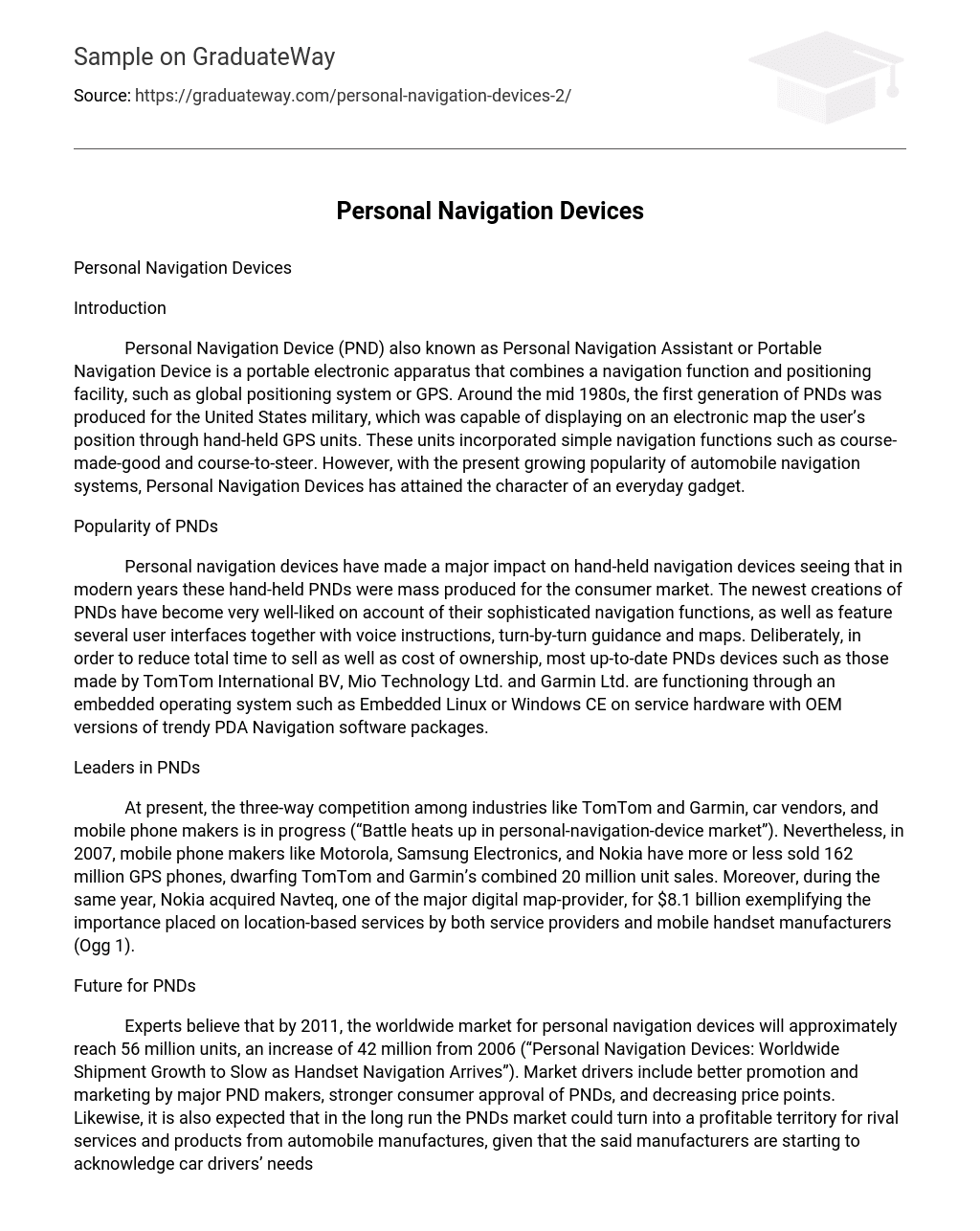Introduction
Personal Navigation Device (PND) also known as Personal Navigation Assistant or Portable Navigation Device is a portable electronic apparatus that combines a navigation function and positioning facility, such as global positioning system or GPS. Around the mid 1980s, the first generation of PNDs was produced for the United States military, which was capable of displaying on an electronic map the user’s position through hand-held GPS units. These units incorporated simple navigation functions such as course-made-good and course-to-steer. However, with the present growing popularity of automobile navigation systems, Personal Navigation Devices has attained the character of an everyday gadget.
Popularity of PNDs
Personal navigation devices have made a major impact on hand-held navigation devices seeing that in modern years these hand-held PNDs were mass produced for the consumer market. The newest creations of PNDs have become very well-liked on account of their sophisticated navigation functions, as well as feature several user interfaces together with voice instructions, turn-by-turn guidance and maps. Deliberately, in order to reduce total time to sell as well as cost of ownership, most up-to-date PNDs devices such as those made by TomTom International BV, Mio Technology Ltd. and Garmin Ltd. are functioning through an embedded operating system such as Embedded Linux or Windows CE on service hardware with OEM versions of trendy PDA Navigation software packages.
Leaders in PNDs
At present, the three-way competition among industries like TomTom and Garmin, car vendors, and mobile phone makers is in progress (“Battle heats up in personal-navigation-device market”). Nevertheless, in 2007, mobile phone makers like Motorola, Samsung Electronics, and Nokia have more or less sold 162 million GPS phones, dwarfing TomTom and Garmin’s combined 20 million unit sales. Moreover, during the same year, Nokia acquired Navteq, one of the major digital map-provider, for $8.1 billion exemplifying the importance placed on location-based services by both service providers and mobile handset manufacturers (Ogg 1).
Future for PNDs
Experts believe that by 2011, the worldwide market for personal navigation devices will approximately reach 56 million units, an increase of 42 million from 2006 (“Personal Navigation Devices: Worldwide Shipment Growth to Slow as Handset Navigation Arrives”). Market drivers include better promotion and marketing by major PND makers, stronger consumer approval of PNDs, and decreasing price points. Likewise, it is also expected that in the long run the PNDs market could turn into a profitable territory for rival services and products from automobile manufactures, given that the said manufacturers are starting to acknowledge car drivers’ needs of new information on the nearest coffee shops, cheapest gas, as well as social networking (“Battle heats up in personal-navigation-device market”).
However, majority of the indications suggest that in the years to come, PNDs are more expected to be prevalently integrated into mobile phones. At present, mobile navigation offers comparable, if not advanced, functionality as other PND manufacturers, yet at a lesser price (“Personal Navigation Devices: Worldwide Shipment Growth to Slow as Handset Navigation Arrives”). Experts believe that wireless service providers are capable of capturing many prospective, price responsive PND buyers; therefore, considerably changing the future market growth of personal navigation devices.
Conclusion
Navigation and mapping utilities have come a long way and, beyond doubt, they materialize on portable devices. Technology today has become very cheap that personal navigation devices integrated in portable consumer electronic devices are as well being considered inexpensive by nearly all consumers. These days, latest production of mass-market PNDs have placed turn-by-turn directions in the palm of every individual’s hand, and it is expected that as these devices become more ordinary, people are also expecting more functions in them. Accordingly, PNDs have become a necessity for all contemporary travelers, enabling people to become a merchant, adventurer and explorer all at the same time.
Works Cited
“Battle heats up in personal-navigation-device market.” 26 August 2008. The Boston Globe Online. 22 May 2009 <http://www.boston.com/business/ ticker/2008/08/battle_heats_up.html>.
Ogg, Erica. “For handset makers, it’s all about location.” 2 October 2007. CNET News. 22 May 2009 ;http://news.cnet.com/For-handset-makers,-its-all-about-location/2100-1041_3-6211070.html;.
“Personal Navigation Devices: Worldwide Shipment Growth to Slow as Handset Navigation Arrives.” 2009. In-Stat. 22 May 2009 ;http://www.instat.com/Abstract.asp?ID=27;SKU=IN0703431ID;.
;





